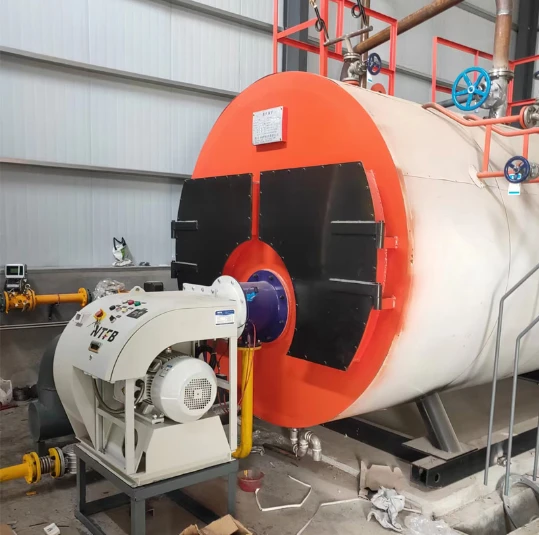
Dec . 15, 2024 22:40 Back to list
Design Considerations for Efficient Thermal Oil Boiler Systems in Industrial Applications
Thermal Oil Boiler Design A Comprehensive Overview
The design of thermal oil boilers is an essential aspect of industrial processes, particularly in sectors such as chemical, petrochemical, food processing, and textiles. Unlike traditional steam boilers that operate on high-pressure steam, thermal oil boilers utilize organic thermal fluids or synthetic oils to transfer heat, making them highly efficient and versatile for various applications.
Principles of Operation
A thermal oil boiler functions on the principle of heating a special thermal fluid, often referred to as thermal oil, which can operate at high temperatures without significant pressure. This unique characteristic allows for safer operations as high-pressure systems are prone to serious safety hazards. The thermal oil is heated in a furnace, and the hot oil circulates through a closed loop system to heat exchangers where the heat is transferred to the process fluids or equipment.
Key Design Parameters
The design of thermal oil boilers involves several critical parameters
1. Heating Capacity The boiler must be designed to meet specific heat requirements of the process. This capacity is measured in kilowatts (kW) and is determined by the heat load calculations of the overall system.
2. Fluid Type Selection of the appropriate thermal fluid is crucial. Common choices include mineral oils, synthetic fluids, or bio-based oils. Each type has its own operating temperature range, viscosity, and specific heat properties, influencing the efficiency and safety of the system.
3. Temperature Control Accurate temperature monitoring is vital for system safety and performance. Advanced control systems automate the regulation of temperatures, ensuring that the thermal oil remains in the desired range.
4. System Design The layout of the boiler and its components—including pumps, heat exchangers, and safety valves—are integral to the efficiency and functionality of the system. The design should facilitate easy maintenance and access to critical components.
5. Safety Features Given the high temperatures involved, incorporating multiple safety features is essential. These may include over-temperature protection, pressure relief valves, and safety shutdown systems to prevent overheating and fluid degradation.
thermal oil boiler design

Material Selection
The materials used in thermal oil boiler construction must withstand high temperatures and resist corrosion. Common materials include carbon steel and stainless steel for the boiler body and high-temperature resistant alloys for the heat exchangers. Insulation materials are also critical; they minimize heat loss and enhance the overall efficiency of the system.
Efficiency Considerations
One of the primary advantages of thermal oil boilers is their efficiency. The ability to maintain high heat transfer coefficients allows for lower fuel consumption compared to traditional systems. Furthermore, thermal oil systems can utilize waste heat recovery methods, significantly reducing operational costs and environmental impact.
Applications
Thermal oil boilers are widely used across various industries. In the chemical industry, they are vital for process heating applications, while in food processing, they facilitate cooking, drying, and frying operations. Textiles utilize thermal oil for dyeing processes, ensuring consistent temperature control.
Future Trends
In recent years, the trend towards sustainability and energy efficiency has influenced the design of thermal oil boilers. Innovations in materials and design, such as the integration of heat recovery systems and the use of biodegradable thermal fluids, are evolving to meet regulatory requirements and environmental concerns.
Conclusion
The design of thermal oil boilers is a complex and multifaceted process that directly impacts industrial efficiency and safety. As industries evolve, the importance of advanced, reliable, and efficient thermal oil boilers will only continue to grow, necessitating ongoing innovation and adaptation in design practices. Understanding the principles of operation, key design parameters, and the latest trends ensures that manufacturers can create effective thermal oil boiler systems that meet the demands of modern industry.
-
Oil Fired Hot Water Boilers Sale - High Efficiency & Affordable
NewsJul.31,2025
-
High-Efficiency Commercial Oil Fired Steam Boiler for Industry
NewsJul.30,2025
-
High-Efficiency Biomass Fired Thermal Oil Boiler Solutions
NewsJul.30,2025
-
High Efficiency Gas Fired Thermal Oil Boiler for Industrial Heating
NewsJul.29,2025
-
High-Efficiency Gas Fired Hot Water Boiler for Sale – Reliable & Affordable
NewsJul.29,2025
-
High Efficiency Biomass Fired Hot Water Boiler for Industrial and Commercial Use
NewsJul.29,2025
Related PRODUCTS






















